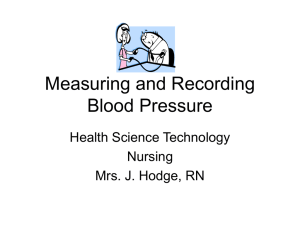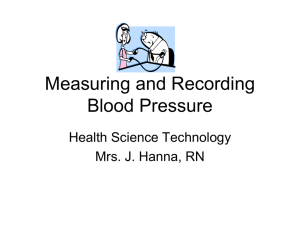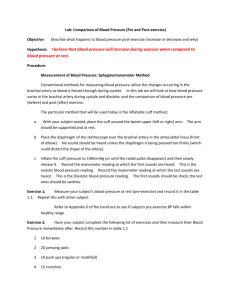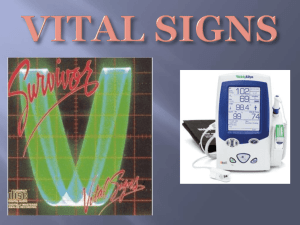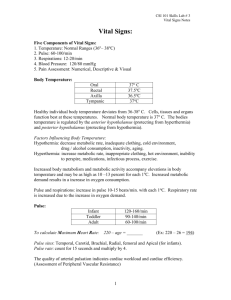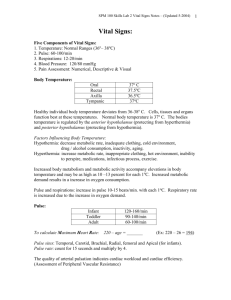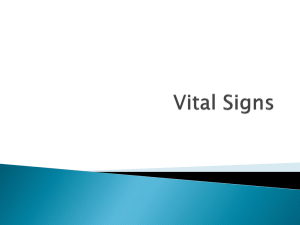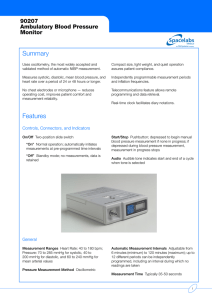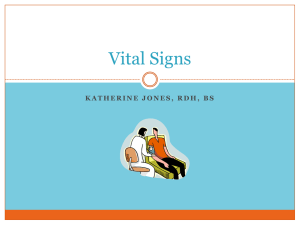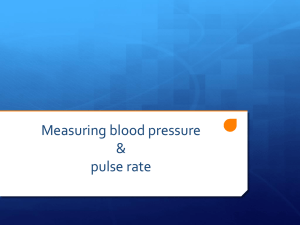L6 Blood Pressure
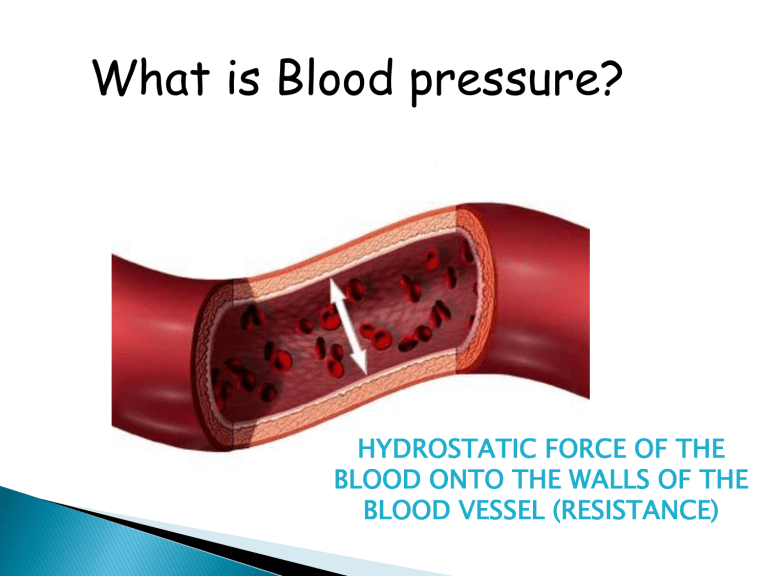
What is Blood pressure?
HYDROSTATIC FORCE OF THE
BLOOD ONTO THE WALLS OF THE
BLOOD VESSEL (RESISTANCE)
What determines blood pressure
Friction between blood (cardiac output) and vessel walls slows down blood flow (peripheral resistance)
When the smooth muscle in the artery or arterioles contract, the vessels constrict, increasing resistance, increasing BP
The opposite happens when they relax
Any factor causing arteries or arterioles to constrict can lead to increased blood pressure (hormones or nerves)
E.g adrenaline, high salt intake, natural loss of elasticity due to age
What is the equation for cardiac output again?
CO=?? x ???
Measuring blood pressure
Use a sphygmomanometer
Cuff inflated to stop blood flow through branchial artery in upper arm
First pressure reading taken when cuff begins to deflate ( systolic pressure )
Second reading taken when pressure falls to where no sound is heard in the artery ( diastolic pressure )
Branchial Artery
• The patient should be relaxed and the arm mu st b e
• supported.
Ensure no tight clothing co nstricts the arm.
2.
• The cuff must be level with heart.
• If arm circumfe rence e xceeds 33 cm,
• a large cuff mu st b e used.
Pla ce stethoscope diaphr agm over
• The col umn of mercury must be vertical .
• Infla te to occlude the pulse. Deflate at 2 to
3 mm/s. Me asu re systolic (first sound) and dia stolic
(disapp earance) to nea rest 2 mm Hg.
…..
© Continuing Medical
Implementation
.bridging the care gap
3
3 values;
Sys (systole)
Dia (diastole
Pulse
For blood pressure
A maximum ( systolic ) and a minimum ( diastolic ) pressure
Blood pressure changes in the aorta during the cardiac cycle.
Measurement of blood pressure using a sphygmomanometer.
An inflatable cuff stops blood flow and deflates gradually.
The blood starts to flow (detected by a pulse) at systolic pressure.
The blood flows freely through the artery (and a pulse is not detected) at diastolic pressure.
A typical reading for a young adult is 120/70 mmHg.
Hypertension is a major risk factor for many diseases including coronary heart disease.
Interpreting blood pressure
Blood pressure expressed as one number over another e.g. 120 over 80 mmHg
Systolic pressure of 120 mmHg
Diastolic pressure of 80 mmHg
Average healthy person has systolic pressure between 100 and 140 mmHg and diastolic pressure between 60 and 90 mmHg
Blood pressure practical
You will be testing each others blood pressure
Draw a table as shown below. Use your instructions to complete the practical
Blood pressure practical
1.
2.
5.
6.
3.
4.
7.
Describe what blood pressure is
What do you use to measure blood pressure?
What does systolic pressure mean?
What does diastolic pressure mean?
What is your blood pressure?
Are you within the ‘normal range’?! (what is that?)
Why is the normal a range and not a specific figure?
Summarise it ....
Complete concept map using words below
blood pressure diameter diastole hydrostatic force of blood hydrostatic force of blood length nerves and hormones number of beats per minute peripheral resistance pulse recoil relax arteriole walls smooth muscle systole
Your patient has a blood pressure of 160 over 95
Write a short paragraph to describe:
What this blood pressure reading suggests
Possible reasons why this patients blood pressure has this reading
Some of the other symptoms you might look out for an why
Oedema is fluid build up in tissues
One sign of high blood pressure
Causes swelling and can be associated with kidney or liver disease
High pressure at artery end causes fluid to be pushed out of capillary walls (interstitial fluid)
Fluid contains plasma and water but NOT red blood cells (why not?)
If BP is too high, too much fluid is forced out of capillaries = oedema
